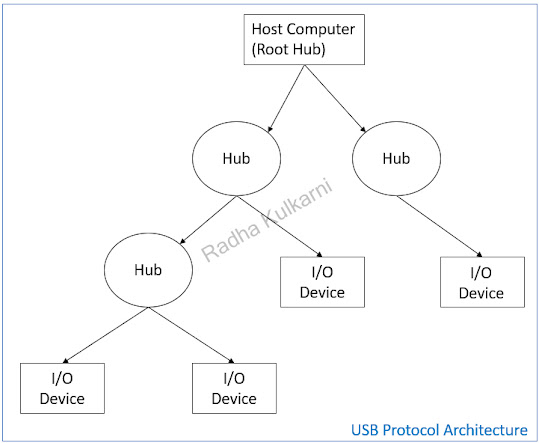USB, which stands for Universal Serial Bus, is an asynchronous communication protocol enabling data exchange and power transfer among electronic devices. Originally developed by Compaq, DEC, IBM, Intel, Microsoft, NEC, and Nortel, USB aims to standardize the connection of peripherals, such as mice, keyboards, printers, etc., to computer systems.
- The different types of USB versions are as follows:
- USB connectors come in various shapes and sizes, each designed for specific purposes. Here are some common types of USB connectors:
- USB Type-A
- USB Type-B
- USB Type-C
- USB Mini
- USB Micro
- USB 3.0
- Working:
- USB operates with a host-slave architecture, where the computer acts as the host or master, and connected peripherals are slaves.
- It supports up to 127 devices due to its 7-bit addressing.
- USB is asynchronous, eliminating the need for a clock signal.
- Here, host can only initiate the Data transfer.
- Now to understand the working let us consider USB type A and USB type B.
- Below digaram shows internal pins of Type A and Type B USB.
The USB connector features four pins (1, 2, 3, 4), with Pin 1 and Pin 4 designated for Vcc (power supply) and Gnd (ground), while Pin 2 and Pin 3 carry D- (data negative) and D+ (data positive) signals. The D+ and D- signals convey the same data, albeit in a mirrored fashion. At the receiver side, a differential amplifier calculates the disparity between D+ and D-, providing a robust mechanism for noise immunity.
USB devices boast hot swapping and plug-and-play capabilities. Hot swapping enables users to connect or disconnect devices while the system is operational, while plug and play ensures that the operating system autonomously identifies and configures connected devices, eliminating the need for manual intervention. The processor continuously monitors the state of I/O devices to facilitate seamless data transmission, relieving I/O devices from the responsibility of updating the processor.
When a new I/O device connects to the hub, it is assigned the address ‘0.’ Subsequently, when the host establishes a connection with the new device, it assesses the device’s capabilities and selects a suitable driver for communication. This dynamic process ensures efficient and tailored communication between the host and the connected I/O devices.
- USB Architecture:
The diagram below illustrates the architecture of the USB protocol, which operates on a Tree Topology.
In this configuration, a single host serves as the central point, and multiple slave devices can be connected to it. I/O devices establish connections with the computer through a Hub, creating a tree-like structure. The Hub functions as the nexus for connecting both I/O devices and the computer, facilitating an organized and efficient network topology.
- USB data format:
In USB communication, data is transferred in the form of packets, categorized into four main types: Token, Data, Handshake, and Start of Frame. To facilitate effective data transmission, USB adheres to a specific message format outlined below:
- SYNC: Every USB packet initiates with a SYNC field, an 8-bit segment utilized for synchronizing the transmitter and receiver to facilitate data transmission.
- Packet Identifier Field (PID): The PID field within the USB protocol serves to identify the type of packet being transmitted. This 8-bit field consists of upper 4 bits indicating the packet type and lower 4 bits representing the bitwise complement of the upper 4 bits.
- Address Field: The address field specifies the address of the USB device involved in the communication. Each USB device connected to a bus is assigned a unique address. The 7-bit address field in a token packet allows for up to 127 unique device addresses.
- Endpoint Field: The endpoint field directs data transfers to and from specific endpoints on a USB device, identified by their endpoint numbers. This 4-bit field in a token packet represents up to 16 different endpoints (0 to 15), with endpoint 0 reserved for configuration, status, and control operations. Additionally, the endpoint field indicates the direction of data transfer — host to device or device to host.
- Data Field: The data field carries the actual information being transferred between the USB host (typically a computer) and the USB device. The length of the data field is not fixed and ranges from 0 to 8192 bits.
- CRC (Cyclic Redundancy Check): CRC is an error-checking mechanism crucial for ensuring the integrity of transmitted data in the USB protocol. It assists the receiver in verifying that the received data matches the original data sent by the transmitting end.
- EOP field: The End of Packet (EOP) field is used to indicate the conclusion of a packet and prepares for the start of the next one, ensuring a well-defined boundary between successive packets.
- Applications of USB Protocol:
- Computer Peripherals: USB is extensively used for connecting a diverse range of computer peripherals, including keyboards, mice, printers, scanners, webcams, and external hard drives.
- Storage: Many hard drives leverage the USB protocol for efficient data transfer, storage, and transportation.
- Smartphones: USB is a key technology for smartphones, serving dual purposes for charging and data transfer between mobile devices and other peripherals.
- Cameras and Webcams: Cameras, webcams, and video streaming devices utilize USB for data transfer and control. USB connections provide a reliable means for transferring multimedia content and enabling communication between imaging devices and computers.
- Gaming Peripherals: USB is commonly employed for connecting gaming peripherals such as controllers, joysticks, and other input devices.
- Industries: USB finds applications in industrial settings, particularly in the connection of sensors, actuators, and other industrial equipment. Its standardized interface simplifies integration and communication in diverse industrial applications.
- Medical Devices: USB is utilized in the medical field to connect various medical devices to computers for data transfer and communication. It ensures a reliable and standardized interface for exchanging data between medical equipment and computer systems, facilitating healthcare operations.







No comments:
Post a Comment